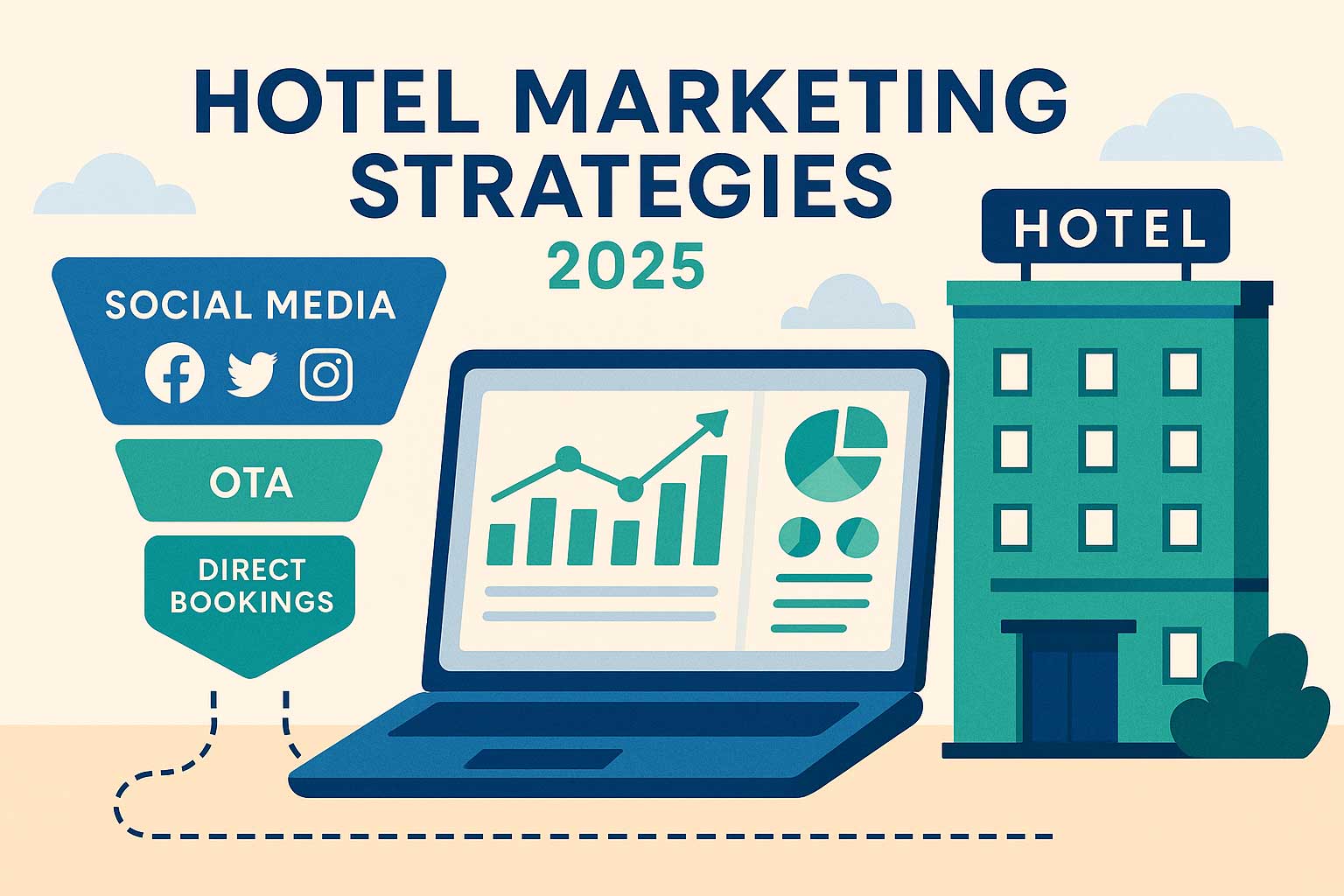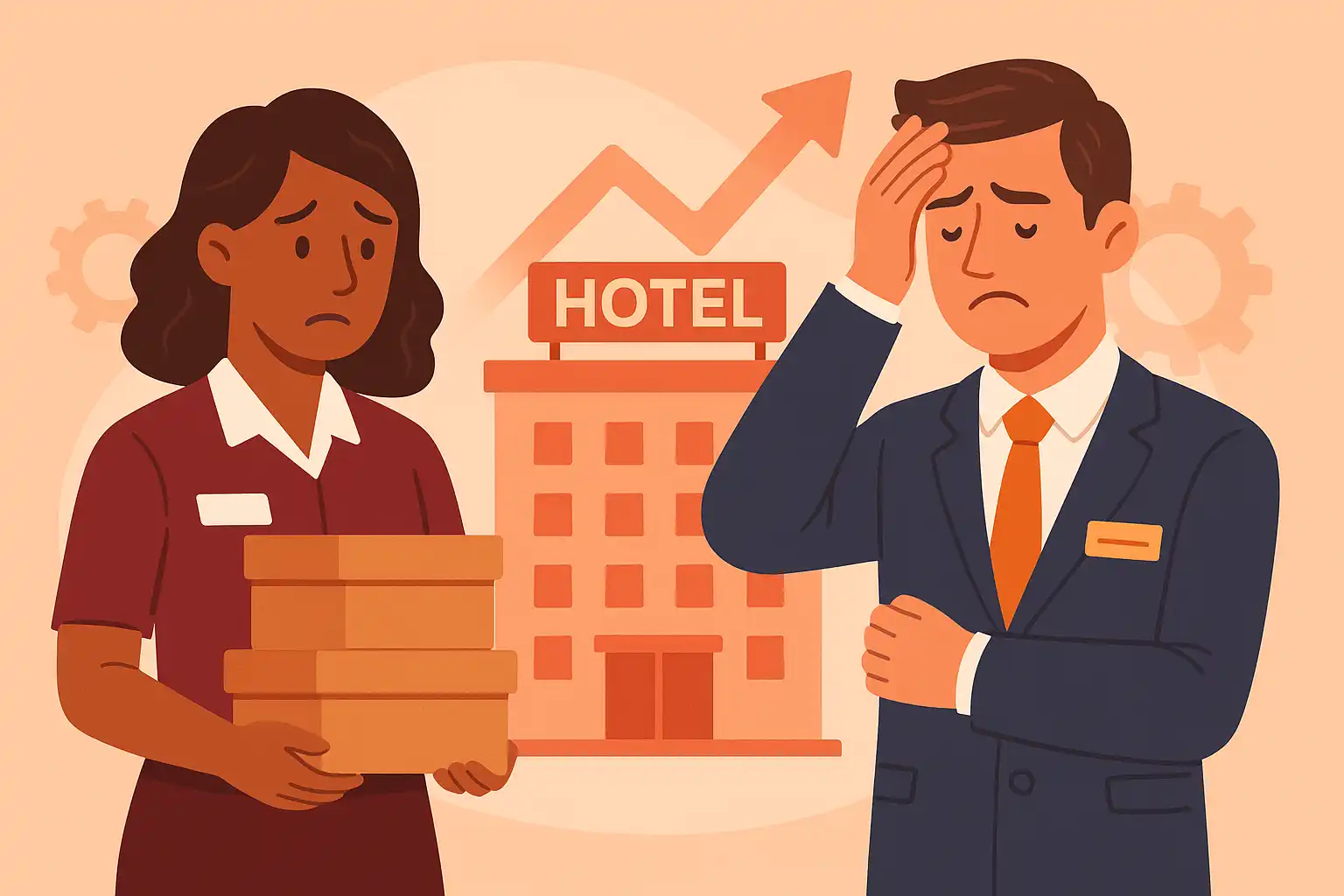Hotel Turnover: Causes, Costs & Effective Solutions for Hospitality
Oct 28, 2025
 Mika Takahashi
Mika TakahashiPopular Categories
Hotel Technology & InnovationHotel Operations OptimizationDigital MarketingIndustry TrendsRevenue ManagementHospitality Industry
Popular Categories
Trending Post

Hotel Walk Letter Template: Professional Guest Communication

Online Travel Agents: What They Are and How They Work

Hotel Security Systems: Modern Protection Solutions

Hotel Advertising: Complete Guide to Boost Bookings and Revenue

25 Hotel Marketing Strategy Ideas for 2025: Complete Guide

AI Reservation Agent: Revolutionizing Hotel Booking and Guest Experience

PMS Communication: Streamlining Property Management Through Effective Guest Messaging
Table of contents
The hospitality industry is facing a serious workforce crisis that’s costing billions and putting service quality at risk across the sector. Unlike other industries that enjoy relatively low turnover rates, hotels often see 70-80% of their staff leave every year. That’s not just a number—it’s a real challenge that impacts daily operations, drives up costs, and hurts the guest experience.
In this guide, we’ll dive deep into the issue of hotel turnover—exploring what causes it, the true costs involved, and the proven strategies that top hospitality companies are using to build stronger, more loyal teams. Whether you’re a hotel manager overwhelmed by constant hiring, an HR professional searching for practical solutions, or an executive aiming to understand the financial impact of staff turnover, this article offers insights to help you turn things around.

What is Hotel Turnover and Why It Matters
Simply put, hotel turnover measures how often employees leave their jobs within hotel operations and need to be replaced. This includes both voluntary turnover—when employees choose to leave—and involuntary turnover, which happens when the employer ends the employment.
Calculating turnover is straightforward: take the number of employees who left, divide it by the average number of employees, then multiply by 100. For example, if a hotel with 100 staff loses 75 in a year, the turnover rate is 75%.
The numbers are eye-opening. Hospitality turnover rates regularly hit 70-80% annually, with some hotels seeing rates as high as 160%. To put that in perspective, the national average turnover across all industries is about 47.2%, so the hospitality sector’s rate is nearly double.
Most hotel turnover is voluntary, driven by reasons like low pay, limited chances for career growth, unpredictable schedules, and workplace stress. This means many employees leave because of issues that hotels can actually fix.
Understanding the difference between voluntary and involuntary turnover is key. While involuntary turnover might be due to performance or misconduct, voluntary turnover points to deeper problems with job satisfaction and the employee experience—areas where hotels can make a real difference.
Current State of Hotel Employee Turnover
According to the latest data from the US Bureau of Labor Statistics, the leisure and hospitality sector sees a monthly turnover rate of 5.7%, well above the overall industry average of 3.4%. That translates to millions of workers cycling through hospitality jobs every year.
Recent studies show that more than 41% of frontline hospitality workers switched jobs in the past year, highlighting just how much movement there is in this sector. In January 2025 alone, over a million new hires were brought in to replace the 781,000 employees who left.
The impact of COVID-19 still lingers. Turnover rates spiked to 65% across hospitality and even higher—70%—in the accommodation and food services sector. Many workers left for gig economy roles, better-paying jobs elsewhere, or exited the workforce entirely. A significant number haven’t returned, reshaping the labor market for hospitality.
Compared to other industries, hospitality’s turnover rate stands out. Manufacturing hovers around 25%, professional services near 15%, but hospitality consistently tops these by two to three times. This shows that while high hotel turnover is a tough challenge, it’s not an unavoidable fact of life—it’s something the industry can address head-on.
Hotels, especially in the accommodation sector, face unique pressures. Many hospitality jobs are entry-level, schedules are often irregular, and clear career growth paths are scarce. As a result, many employees see hotel jobs as temporary gigs rather than long-term careers.

Root Causes of High Hotel Turnover
To tackle hotel turnover, we first need to understand why employees walk away. While some turnover is natural given the seasonal nature of many hospitality jobs, most stems from problems that hotels can fix with the right approach.
Low Wages and Financial Stress
Money talks. For many hospitality workers, low pay is the biggest source of frustration. As of mid-2025, the average hourly wage for non-supervisory hospitality workers is $19.61, but many hotel roles still pay minimum wage, making it tough for employees to make ends meet.
Tips have traditionally helped supplement income, but with fewer guests carrying cash, tip income has become less reliable. This unpredictability adds to financial stress.
Location matters too. What might be a livable wage in one city falls short in another with higher living costs. Many hospitality workers juggle multiple jobs or look for better-paying roles elsewhere.
The tipped wage system can also cause headaches, with delayed or disputed tip payments frustrating frontline staff who rely on these earnings.
Lack of Career Advancement Opportunities
Many hotel jobs don’t offer much beyond basic training, limiting employees’ chances to grow skills or move up. Unlike industries with clear promotion ladders, hospitality often offers sideways moves with little increase in pay or responsibility.
Younger workers often treat these jobs as temporary while pursuing education or other careers. Without clear paths for career growth, hotels lose these ambitious workers to other fields.
Programs for cross-training, mentorship, and clear promotion routes are still rare in many hotels. Loyal and capable employees often take on extra work without recognition or pay raises, leading to frustration and eventual exit.
Scheduling and Work-Life Balance Issues
Hotels never close, so shifts run around the clock. That means nights, weekends, and holidays are the norm—making it hard for employees to balance work with family or personal life.
Many hotel jobs are physically demanding with long shifts, which combined with unpredictable scheduling, leads to burnout.
Irregular hours make it tough for employees to plan ahead, pursue education, or take care of family. Requests for schedule changes often go unanswered, adding to resentment.
The hospitality sector asks a lot from employees but often doesn’t offer the flexibility workers need.
Toxic Work Environment and Management Problems
Workplace harassment is sadly common. Studies show 9 out of 10 women in hospitality experience sexual harassment, compared to 3 out of 10 in other industries. This toxic environment drives many away.
Poor communication, micromanagement, and lack of supportive leadership also harm workplace culture. When employees feel undervalued or disrespected by managers, they look elsewhere.
The high-pressure nature of hospitality work, combined with demanding guests and tight budgets, creates stress that, if unmanaged, leads to burnout.
Favoritism and unfair treatment further poison the work environment, pushing good employees out.
Limited Benefits and Recognition
Many hotel jobs offer few benefits—no health insurance, retirement plans, or paid time off—which leaves employees feeling undervalued.
Recognition programs are often lacking, even though research shows 74% of workers perform better when appreciated.
Beyond pay, employees want to feel their employer cares about their well-being and development. Without benefits like wellness programs or educational assistance, hotels struggle to hold onto talent.
Competitive wages alone aren’t enough. Employees expect a full package that includes career growth, financial security, and recognition.
The True Cost of Hotel Turnover
Replacing employees isn’t cheap. SHRM estimates it costs about $4,700 to replace a single hire, covering ads, interviews, and onboarding.
But that’s just the start. Total costs can range from 30% to 150% of an employee’s annual salary when you factor in lost productivity, overtime for remaining staff, poorer guest experiences, and management time spent recruiting instead of running operations.
When staff leave suddenly, the extra work falls to those left behind, causing burnout and more departures—a vicious cycle.
Guest satisfaction takes a hit too. Research from Cornell shows that a 1% increase in turnover can reduce guest satisfaction scores by 5%, leading to fewer repeat visits and negative reviews.
Experienced employees carry institutional knowledge about guests and operations that new hires can’t quickly replace, hurting consistency and efficiency.
Training new hotel staff takes time and resources, and during this ramp-up period, service quality often dips.

Proven Strategies to Reduce Hotel Turnover
Fixing turnover means addressing root causes and building a positive workplace culture. Even small changes can make a big difference when done thoughtfully.
Competitive Compensation and Benefits
Paying competitive wages is the foundation. Regularly reviewing and adjusting pay to exceed local market rates shows employees they’re valued.
Benefits like health insurance, retirement plans, and paid time off provide financial security and encourage loyalty.
On-demand pay programs, letting workers access earned wages before payday, reduce financial stress and boost satisfaction.
Tiered pay systems that reward tenure and performance motivate employees to stay and build expertise.
Beyond basics, perks like flexible spending accounts and employee assistance programs address hospitality workers’ unique needs.
Career Development and Internal Growth
Clear career paths with defined milestones give employees goals and show that hospitality can be a long-term career.
Cross-training programs, like Orient-Express’s Trading Places, build versatile skills and keep employees engaged.
Formal training boosts retention—employees in development programs stay 20% longer on average.
Internal academies offering debt-free education demonstrate employer investment and pay off in loyalty.
Mentorship connects new hires with experienced staff, improving satisfaction and knowledge transfer.
Flexible Scheduling and Work-Life Balance
Offering shift swaps, part-time options, and advance scheduling helps employees balance work and life.
Mobile scheduling apps give employees control and transparency, increasing job satisfaction.
Respecting personal time and ensuring breaks show employees they’re valued beyond just their work hours.
Technology Solutions to Reduce Workload
Mobile check-in/out systems ease front desk pressure, letting staff focus on guest service.
Automated messaging handles routine communications, freeing employees for higher-value tasks.
Upselling tech reduces sales pressure on staff while boosting revenue.
Guest management systems streamline operations and reduce administrative burdens, improving workplace efficiency.
Recognition and Company Culture Improvements
Simple recognition programs—employee of the month, shout-outs, rewards—boost morale and retention.
Team events and social activities build community and belonging.
Addressing toxic environments with clear policies and enforcement shows commitment to employee wellbeing.
Open communication and feedback channels build trust and help catch issues early.
Employee engagement initiatives give workers a voice and foster loyalty.
Success Stories and Industry Examples
Charton Management’s QSR division cut turnover by offering financial wellness programs, including earned wage access and counseling, creating a more stable workforce.
Several hotel brands have launched internal academies for debt-free education, boosting retention and internal promotions.
Woolverton Inn’s Room Check rewards housekeepers for quality work with immediate recognition and bonuses, improving both service and satisfaction.
Charleston Place’s WOW! Program focuses on recognition, development, and career growth, leading to better employee satisfaction and guest service.
Hotels using tech for payroll and scheduling report up to 25% higher employee satisfaction, translating into lower turnover and smoother operations.
Integrated workforce management systems improve communication, scheduling flexibility, and admin efficiency, paying off in better retention.
Comprehensive benefits packages help hospitality companies attract and keep higher-quality employees.
The Future of Hotel Workforce Retention
More hotels are realizing that their roles should be career entry points, not just temporary jobs. This means changing how they approach pay, culture, and development to compete in a tight labor market.
As other industries offer better pay, flexibility, and growth, hotels must step up their game and highlight the unique opportunities hospitality careers provide.
Treating employees as long-term investments requires upfront effort and resources, but the payoff is lower turnover and stronger operations.
Hotels that build stable, skilled teams gain a competitive edge through better guest experiences and stronger reputations.
Technology will keep playing a key role in improving scheduling, communication, and workload management.
